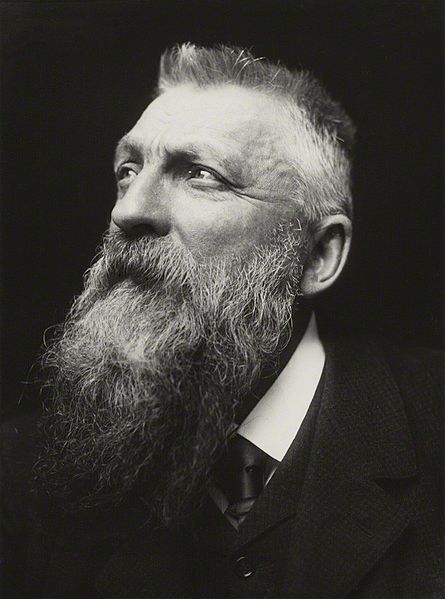
Born: 12 November 1840, Paris
Died: 17 November 1917 (aged 77)
Known for: Sculpture
The Life of Auguste Rodin
François-Auguste-René Rodin was a French sculptor widely regarded as one of the progenitors of modern sculpture. His innovative approach to form and detail, breaking away from traditional practices, marked a significant shift in the art of sculpture. Here’s a summary of his life and contributions to art:
Early Life and Education
- Born on November 12, 1840, in Paris, Rodin showed an early interest in drawing and sculpting. Despite his talent, he faced repeated rejections from the prestigious École des Beaux-Arts in Paris.
- He initially worked in decorative arts and craftsman jobs to support himself, honing his skills in sculpting and understanding materials.
Artistic Development
- Rodin’s early work was influenced by his travels to Italy in 1875, where he was profoundly impacted by the work of Michelangelo. This experience encouraged him to pursue sculpture with a renewed vigor and a focus on expressing the human condition.
- In 1877, Rodin exhibited “The Age of Bronze,” which earned him both acclaim and controversy. The sculpture’s realism was such that critics accused him of casting from a living model, which was considered cheating. This event, however, helped establish his reputation.
Major Works and Achievements
- Rodin is best known for “The Thinker” (originally titled “The Poet”), “The Kiss,” and “The Gates of Hell,” a monumental project inspired by Dante’s “Inferno” that he worked on for decades but remained unfinished at his death. “The Gates of Hell” served as a canvas for Rodin to explore human emotion and condition, and it included figures that would become sculptures in their own right, such as “The Thinker.”
- His approach to sculpture was characterized by dynamic surfaces, fragmented bodies, and the use of partial figures to express movement and emotion, diverging from the polished forms of his predecessors.
Later Life and Legacy
- Rodin faced both criticism and celebration throughout his career. By the early 20th century, he was recognized as a leading figure in the art world.
- He became a wealthy and prominent artist, forming relationships with other notable figures of his time, including writers, artists, and thinkers.
- In 1916, Rodin donated his works and collections to the French state, leading to the establishment of the Musée Rodin in Paris, where much of his work is displayed.
- Rodin passed away on November 17, 1917, in Meudon, France. His legacy is that of an artist who revolutionized sculpture, influencing countless artists and leaving an indelible mark on the world of art.
Auguste Rodin’s life and work represent a pivotal moment in the history of art, where the focus shifted from idealized forms to a more truthful and dynamic representation of the human spirit and body. His sculptures continue to inspire and awe, cementing his place as a master of modern sculpture.
Auguste Rodin’s Notable Works
Auguste Rodin’s oeuvre marked a significant departure from classical conventions, focusing on the emotional and physical realism of the human form. His sculptures are celebrated for their dynamic expression, texture, and innovative compositions. Here are ten of his most famous works:
- The Thinker (Le Penseur, 1880-1882) – Originally part of “The Gates of Hell,” this bronze sculpture represents a man in deep contemplation and has become one of the most iconic images in art history.
- The Kiss (Le Baiser, 1882) – This marble sculpture depicts an intimate moment between lovers Paolo and Francesca, characters from Dante’s “Divine Comedy,” capturing the passion and tragedy of their story.
- The Gates of Hell (La Porte de l’Enfer, 1880-1917) – A monumental bronze door intended for a museum that was never built, featuring over 180 figures and illustrating scenes from “The Inferno,” part of Dante Alighieri’s “Divine Comedy.”
- The Burghers of Calais (Les Bourgeois de Calais, 1884-1889) – Commissioned to commemorate the heroism of six citizens of Calais during the Hundred Years’ War, this bronze group sculpture is renowned for its portrayal of anguish and sacrifice.
- The Age of Bronze (L’Âge d’Airain, 1877) – One of Rodin’s early works, this life-size bronze figure caused controversy for its realism, with critics alleging that it was cast from a living model.
- Monument to Balzac (Monument à Balzac, 1898) – Commissioned by the Société des Gens de Lettres, this sculpture of the French novelist Honoré de Balzac was initially criticized for its abstract and unconventional portrayal but is now celebrated for its visionary approach.
- Eternal Springtime (L’Éternel Printemps, 1884) – A marble sculpture depicting a passionate embrace between lovers, characterized by its fluidity and dynamic movement.
- The Cathedral (La Cathédrale, 1908) – Two right hands, almost touching, create a space between them reminiscent of Gothic architecture, symbolizing spiritual unity and contemplation.
- The Walking Man (L’Homme qui marche, 1877-1878) – A study in movement, this fragmented figure, lacking arms and a head, focuses on the dynamism and muscularity of the male body.
- Saint John the Baptist Preaching (Saint Jean-Baptiste prêchant, 1878) – Another life-sized work that emphasizes naturalism and the raw physicality of the human form, representing the biblical figure in a moment of passionate oratory.
Rodin’s influence on modern sculpture cannot be overstated; his innovative approach to form, material, and subject matter has inspired countless artists, making him a central figure in the development of modern art.